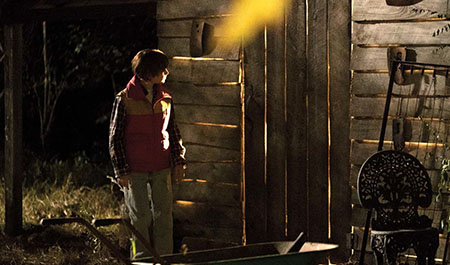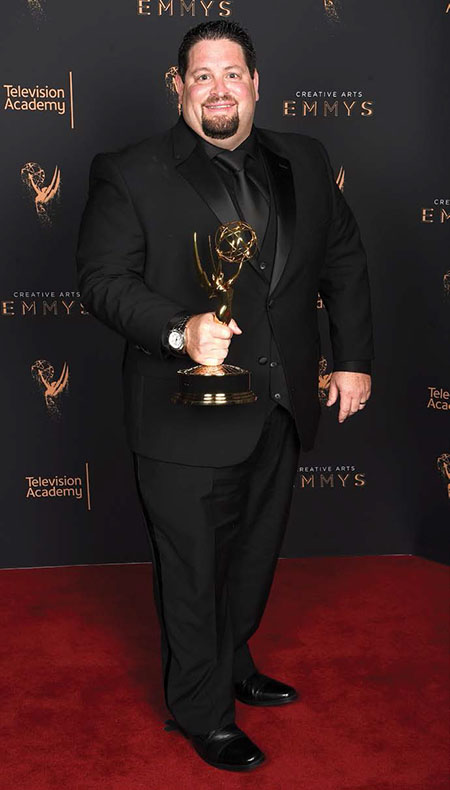Zimmerman No ‘Stranger’ to Editing Excellence
As Dean Zimmerman received the golden statuette for “Outstanding Single-Camera Picture Editing” on the stage of the Microsoft Theater in Los Angeles last month, for cutting Netflix’s “Stranger Things Chapter One: The Vanishing Of Will Byers,” there was no doubt in his mind where this journey to this Creative Arts Emmy had begun.

Zimmerman received an Emmy for his work cutting Netflix’s “Stranger Things Chapter One: The Vanishing of Will Byers.”
Curtis Baker/Netflix
He was 13, in the Cary Grant theater on the Sony Pictures lot at the premiere of “Rocky IV.” With tears in his eyes he went running up the stairs to the rear console where Stallone and all the producers were sitting and jumped into his father’s lap. Young Dean knew that what his father had done was how he wanted to build his own career—choosing images and pictures, sights and sounds that combined to move people in a way that no other medium could equal. You see, his father was Don Zimmerman, the editor of “Rocky IV.”
Dean Zimmerman had chosen his life’s work, but despite his father having been nominated for an Academy Award for editing Hal Ashby’s “Coming Home,” he set out to do it on his own. He went to St. Mary’s College in the Bay area, then got a job at 18 at Pacific Title as a driver on the graveyard watch.
PA grunt shifts got him near cutting rooms until he became an apprentice editor on “A Walk in the Clouds” in 1995. Moving up the ranks of assistants he was qualified to be his dad’s assistant editor on “The Cat in the Hat” in 2003.
They worked together on several films including the original “Night at the Museum” which eventually lead to Dean Zimmerman taking the editor’s seat on 2010’s “Date Night” produced by Shawn Levy.

Dean Zimmerman accepts his award at the 2017 Creative Arts Emmys.
Jordan Strauss/Invision for Television Academy/AP Images
ON UNTEMPERED TURF
When Levy pitched the idea to Netflix to tackle a new episodic called “Stranger Things”, Zimmerman was so impressed with the script he responded to Levy’s call by signing on for seven weeks.
But coming from the world of features, Zimmerman was not prepared for the fact that since this was Netflix’s first foray into producing a TV series, he and his fellow editor, Kevin D. Ross (“Halt and Catch Fire,” “Californication”), would be treading on untempered turf.
“Getting in on the ground floor meant there were a lot of post-production procedures we had to institute into the Netflix operation,” Zimmerman recalled. “It was up to us to create a grand plan for post, treating the series like one big eight-hour feature film.”
“Stranger Things” is not your typical TV episodic, but one reason for its growing popularity is the craftsmanship that goes into its creation. In fact, this year it garnered an impressive five separate Creative Arts Emmys, from Sound Editing to the design of the title sequence, which actually started being composed before principle photography began.
Trying hard to avoid spoilers here, episode one of “Stranger Things” is the story of a fairly typical American small town situated near an Area 51 shadowland. Episode one deals with one kid (probably Will Byers) mysteriously disappearing and another one just as inexplicably coming onto the scene. Meanwhile, teens fall in love, parents squabble, and something just isn’t right in the background.
Zimmerman credits the directing Duffer brothers, Matt and Ross, for giving him and Kevin Ross a lot of freedom in the cutting room as they checker boarded editing the episodes.
“We basically took the best from the feature film workflow, which was my background, and the best from television episodics workflow, which was Kevin’s background, and created new procedural templates which became the model by which Netflix now approaches post production,” Zimmerman said. “They gave us the responsibility for making great creativity, and it was a great experience working with them.”
A CHILD’S TEARS
As every editor knows, what finally appears on the screen, be it big or little, stems from a collaborative process. In the episode, “Stranger Things Chapter One: The Vanishing of Will Byers,” Zimmerman feels there were some instances where scenes were significantly enhanced in the edit bay.
Again, under the constraints of not giving away too much of the plot, Zimmerman was able to let us look over his shoulder while one of the key scenes evolved significantly as its timeline moved through his Avid Media Composer.
“I love to add a layer of comedy into serious scenes to unlock the tension,” he began. “In Episode One there is a dinner table scene where the parents are talking about an evening curfew being imposed by the local sheriff after some children have disappeared.”
The daughter complains she wants to meet her study buddy (i.e. clandestinely link up with her boyfriend), while the son is determined to get out to search for his missing best friend.
The rebellion escalates while caught in the middle is a sweet little two year-old trying to make sense of the mounting conflict.
“We had a close up of her, which I cut away to. But it didn’t seem enough,” Zimmerman said. “So we started looking though out takes, or footage before the slates. The Duffer brothers even went out and shot some pick-ups of the kid for us. Heck, we went so far as to cut in close ups of the child out of split screens.”
As you will see in the final version, the family’s mounting emotional interplay gets played off the face of this innocent child who is progressively dissolving into tears.
“We even had the child actor’s real mother come in and sit next to her so we could get some deeper emotion out of the little girl,” Zimmerman recalls. “On the set it was all very safe for her. But as we intercut her reactions into the scene, her emotions serve as an almost humorous counterpoint to the vitriol that is swirling around her.”
A child being deeply moved by the juxtaposition of sound and imagery? Does that sound vaguely familiar?
“We even reversed the motion on some of the shots to make sure the child was reacting to the proper person,” Zimmerman said. “We pulled out all of the tricks in the book.”
When Netflix expressed how blown away they were at how much could be done in the edit bay, Zimmerman’s reaction was one every budding editor could benefit from.
“Oh, no,” he said. “You gave us all the material. We just put it together for you.”
I can just see that statuette on his shelf… winking.
Jay Ankeney is a freelance editor and post-production consultant based in Los Angeles. Write him atjayankeney@mac.com.
Get the TV Tech Newsletter
The professional video industry's #1 source for news, trends and product and tech information. Sign up below.
